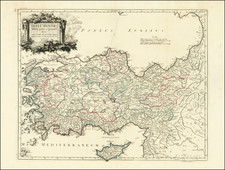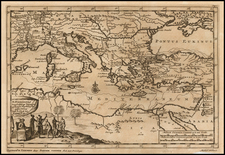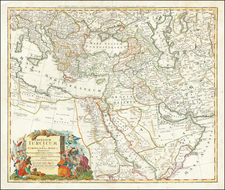Jansson’s Bird’s Eye View of Istanbul
Rare and striking bird’s-eye view of Istanbul, from Jansson’s important town book.
Jansson's view is the third state of this plate, which was originally published as part of Braun and Hogenberg’s seminal Civitatis Orbis Terrarum (1572-1618). The Jansson third state, which removes the roundels from the bottom edge, is much rarer than either of the two Braun and Hogenberg states.
Jansson's eight volume Theatrum Urbium was the most comprehensive Dutch town book of the seventeenth century. While similar in format to Braun and Hogenberg's Civitatis Orbis Terrarum, Jansson’s was in many respects a significant improvement, both in the scope of the towns depicted and the quality of the views. Moreover, it was perhaps the only work by Jansson which surpassed the comparable work of the Blaeu Family, whose own atlas of town views was never completed.
In 1653 Jansson acquired the nearly 500 plates of the Civitates Orbis Terrarum from Abraham Hogenberg, of which 232 were adapted and incorporated into his own town book. For many plates of the cities of the Netherlands, however, Jansson ordered new copperplates.
Viewed across the Bosphorus from the village of Scutari (Üsküdar), the city is shown with an emphasis on its fortifications and famous buildings. Pera-Galata is across the Golden Horn, to the right of the view.
Many of the great buildings of the city are evident, including the Topkapi Palace. The Hagia Sophia is near to the palace, while the many-domed Fatih Mosque complex sprawls toward the western city walls. Just outside the city walls, at left, is the rising Tekfur Palace. In Pera are the new shipyards.
Along the view’s lower edge, Suleiman the Magnificent rides at the center. The Ottomans sultans have their portraits on either side of him, from Osman Bey to Murad III.
Sixteenth-century mapping of Istanbul
This view is part of a sequence of that showed the city as it grew in size and importance in the sixteenth century. The first surviving map to show a bird’s-eye-view of the city in this configuration was by Giovanni Andrea Vavassore. Published in Venice in 1520, the view is clearly the inspiration for later productions by Sebastian Münster (1544) and Braun and Hogenberg (1572). Vavassore, in turn, supposedly based his view on a 1480 map by Giovanni Bellini, but it has not survived.
Both Münster and Braun and Hogenberg improved upon their predecessor’s work, adding details to the grand buildings of the city. For example, the Hippodrome is much more accurately rendered, while many other churches and administrative buildings are more precisely located and depicted.
The main difference between the Münster and the Braun and Hogenberg are the decorative features along the bottom of the view. Sulieman the Magnificent (1494-1566) sits proudly atop a majestic steed, surrounded by armed attendants. To his left and right are roundels showing the sultans of the Ottoman Empire.
Sulieman strengthened the empire and terrified the Christian leaders of Europe. The title of the Braun and Hogbenberg view, Byzantium Nunc Costantinopolis, is likely a European attempt to undermine the legitimacy of the Ottomans, suggesting the earlier presence and power of the Byzantine Empire.
This view of the city continued to be influential, affecting the layout of views well into the following century. For example, Jansson reprinted the Braun and Hogenberg view (which appeared in two states) in a third state in his own town book in the mid-seventeenth century. Versions of the view were printed into the nineteenth century.
Constantinople
The city of Istanbul, previously known as Constantinople, has its roots in the seventh century BCE. By the first century BCE, Byzantium was a thriving settlement. The independence of the city ended in the late second century CE, when Septimus Severus and his Roman army conquered it by siege. Severus rebuilt the damage he caused and the city soon became a prominent Roman metropolis thanks in large part to the its natural defensibility and strategic location.
These attributes led Constantine the Great to make the city the capital of the Roman Empire; it was renamed Constantinople in 330 CE. A Christian city, Constantinople was soon defined by its churches, including the Hagia Sophia and the Hagia Irene.
The city survived the fall of Rome and continued to fashion themselves as the heir to the Roman Empire for over a thousand years. The Ottomans conquered Constantinople in 1453, making it the capital of their own empire. The Turkish government changed the city’s name to Istanbul in 1930.
Interestingly, the term Byzantine was not applied to an empire until the nineteenth century. First coined by a Hapsburg scholar, Hieronymous Wolf, in 1557, it was taken up by historians to refer to the later or eastern Roman Empire.
Jan Janssonius (also known as Johann or Jan Jansson or Janszoon) (1588-1664) was a renowned geographer and publisher of the seventeenth century, when the Dutch dominated map publishing in Europe. Born in Arnhem, Jan was first exposed to the trade via his father, who was also a bookseller and publisher. In 1612, Jan married the daughter of Jodocus Hondius, who was also a prominent mapmaker and seller. Jonssonius’ first maps date from 1616.
In the 1630s, Janssonius worked with his brother-in-law, Henricus Hondius. Their most successful venture was to reissue the Mercator-Hondius atlas. Jodocus Hondius had acquired the plates to the Mercator atlas, first published in 1595, and added 36 additional maps. After Hondius died in 1612, Henricus took over publication; Janssonius joined the venture in 1633. Eventually, the atlas was renamed the Atlas Novus and then the Atlas Major, by which time it had expanded to eleven volumes. Janssonius is also well known for his volume of English county maps, published in 1646.
Janssonius died in Amsterdam in 1664. His son-in-law, Johannes van Waesbergen, took over his business. Eventually, many of Janssonius’ plates were sold to Gerard Valck and Pieter Schenk, who added their names and continued to reissue the maps.









![[ Ancient Greece & Balkans ] Illyricum, Dacia, Moesia Macedonia et Thracia](https://storage.googleapis.com/raremaps/img/small/102174.jpg)
![Turcia Turci Cive Imperii seu Solij mannorum regni pleraque pars nunc recens Summa fide ac indusrai elucubrata | Natoliam Moderni dicunt tam partem quam Asiam minrem appelauere veteres. [shows Cyprus]](https://storage.googleapis.com/raremaps/img/small/86757.jpg)
![Russian Empire [with] Chart of the Communication Between The Archipelago And Black Sea](https://storage.googleapis.com/raremaps/img/small/64013.jpg)


